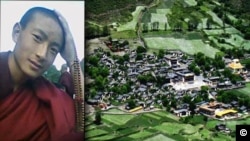Lobsang Lozin, a monk from Gyalrong Tsodrun Kirti Monastaery in BharkhamDzong, a small county township in Ngaba (Ch:Aba, Sichuan) set himself on fire around noon on Tuesday and died on the spot.
A source in India told VOA that the 18-year old took up to 80 steps towards government buildings while still ablaze and shouted slogans, although the words he was saying could not be verified at this time.
A photograph of Lobsang Lozin collapsed in the street and in flames show several onlookers with hands clasped in prayer.
Lobsang Lozin belonged to the Khargotsang family at Sholachang villageand the son of Jorgyal and Tsepopo. According to sources, the young monk was a highly popular and successful student in his monastery.
Gyalrong Tsodun Kirti Monastery is one of the branch monasteries of Kirti monastery in Ngaba town, which has been under severe restrictions and re-education campaigns since 2008, and where the majority of the self-immolations over the last two years have occurred.
Save
Immediately following Lozin’s self-immolation, a heavy contingent of armed police were reported moving towards the monastery and local Tibetans are said to have blocked a bridge, possibly in an effort to prevent Lozin’s body from being taken away.
It is not known as of this time whether the security forces reacted with violence to the bridge blockade as they have done in similar past incidences in Tibetan areas of Sichuan. Fellow monks had taken Lobsang Lozin’s body to the monastery where prayers and rituals for the deceased were started, and where he is planned to be cremated later in the evening. Last March, two monks from the same monastery, Chime Palden and Tenpa Dhargyal, had also self-immolated and died.
Lobsang Lozin is the 44th Tibetan to have set themselves on fire in Tibet in protest against Chinese policies and governance, while calling for the return of the Dalai Lama to Tibet.
China’s reactions to the self- immolations taking place across all Tibetan territories has shifted from time to time. Beiijing has called the protesters ‘terrorists’, social failures and outcasts, people who are easily manipulated by ‘outside forces’, and blamed the Dalai Lama, but have not started a serious investigation into the underlying causes of any one of the 44 cases to date.
Exile Tibetan authorities and groups say that the acts are born out of desperation stemming from repressive pressures on Tibetan lives and culture and that China’s routine use of detention and torture against Tibetan demonstrators leave no other options for expressing grievances.
A source in India told VOA that the 18-year old took up to 80 steps towards government buildings while still ablaze and shouted slogans, although the words he was saying could not be verified at this time.
A photograph of Lobsang Lozin collapsed in the street and in flames show several onlookers with hands clasped in prayer.
Lobsang Lozin belonged to the Khargotsang family at Sholachang villageand the son of Jorgyal and Tsepopo. According to sources, the young monk was a highly popular and successful student in his monastery.
Gyalrong Tsodun Kirti Monastery is one of the branch monasteries of Kirti monastery in Ngaba town, which has been under severe restrictions and re-education campaigns since 2008, and where the majority of the self-immolations over the last two years have occurred.
Save
Immediately following Lozin’s self-immolation, a heavy contingent of armed police were reported moving towards the monastery and local Tibetans are said to have blocked a bridge, possibly in an effort to prevent Lozin’s body from being taken away.
It is not known as of this time whether the security forces reacted with violence to the bridge blockade as they have done in similar past incidences in Tibetan areas of Sichuan. Fellow monks had taken Lobsang Lozin’s body to the monastery where prayers and rituals for the deceased were started, and where he is planned to be cremated later in the evening. Last March, two monks from the same monastery, Chime Palden and Tenpa Dhargyal, had also self-immolated and died.
Lobsang Lozin is the 44th Tibetan to have set themselves on fire in Tibet in protest against Chinese policies and governance, while calling for the return of the Dalai Lama to Tibet.
China’s reactions to the self- immolations taking place across all Tibetan territories has shifted from time to time. Beiijing has called the protesters ‘terrorists’, social failures and outcasts, people who are easily manipulated by ‘outside forces’, and blamed the Dalai Lama, but have not started a serious investigation into the underlying causes of any one of the 44 cases to date.
Exile Tibetan authorities and groups say that the acts are born out of desperation stemming from repressive pressures on Tibetan lives and culture and that China’s routine use of detention and torture against Tibetan demonstrators leave no other options for expressing grievances.






